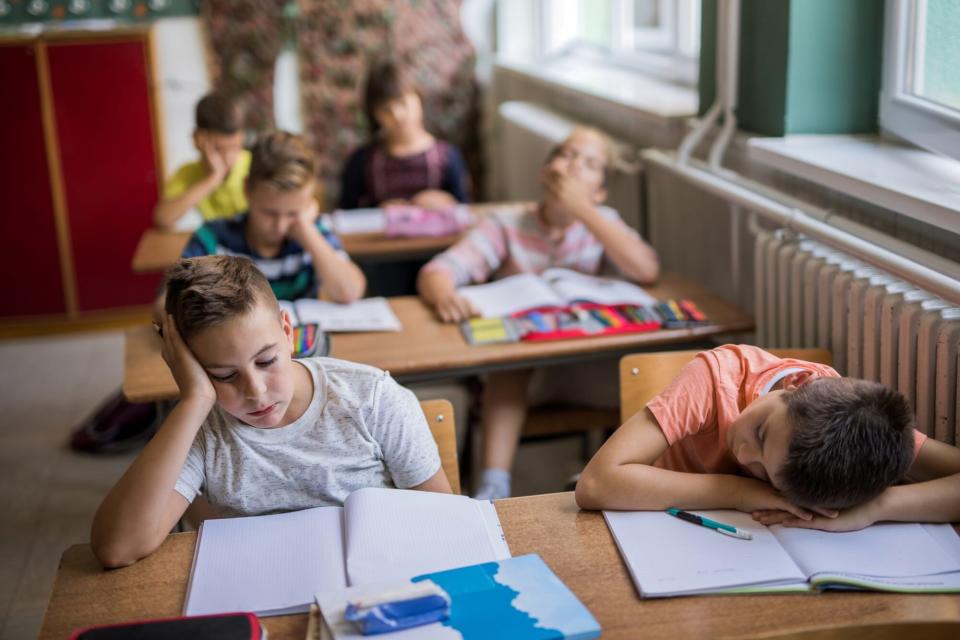TikTok Teacher Allows Students to Sleep in Class—but What Do the Experts Say?
For students, dozing off at their desk is usually considered a no-no, punishable by detention or at least a note home. But one former middle school teacher went viral for a video encouraging teachers to empathize with students who doze off in class.
"Sometimes, the nicest thing a teacher can do for a student is let them come in, lay their head down, and go to sleep," said TikTok user @bcholeman.
He went on to explain why it's important to put yourself in the student's shoes before labeling them as lazy. "I had a student who came into class today, and he was visibly upset," he continued.
Before class started, one of the student's friends let the teacher know that his grandfather had just died. So when he went to administer a test that day, the student's had a special note: "I'm sorry for your loss. I'm praying for you. You already have a 100 on this test. Just turn it in."

Getty Images.
"I don't say this to brag, and I don't say this to build myself up," the former teacher said. "I say this because sometimes, as teachers, our tests are not as important as our student's personal life."
The video has racked up 7.4 million likes and 89.3K comments, many of which gave the TikToker a virtual standing ovation.
"We need more teachers like you. As a mom of three teens, thank you," said one person. "Imagine having a fair and understanding teacher … we need more people like you," concurred another. "You make me believe in the power of schools again," another said.
While the video is from February of 2020, Dr. Regine Muradian, Psy.D., a licensed clinical psychologist, says it's good that it's resurfacing now as children head back to the classroom during the pandemic. Some youngsters are worried, and defaulting to compassion rather than anger may help make things a little easier.
"Teachers are like first responders, and they need to know what to do [in difficult situations]," says Muradian, who helped start Team Project RISE, a program aimed at helping train educators to help students with mental health issues during the ongoing pandemic.
But is letting a student sleep through class the way to go? It's complicated. Karen Aronian, Ed.D., a New York-based parenting and education expert, is encouraged by the video. She says some teachers incorporate mental health breaks into their students' days, where they let kids put their heads down on their desks for five minutes.
But Aronian doesn't think it's a good idea to turn a blind eye to a student sleeping in class. "They're there to get information, lessons, and learn," she explains. That said, she doesn't think teachers should use punishment if they catch their students snoozing.
"When you see that behavior, you want to come at it with compassion and empathy," she says. "That's how you're going to build communication, connection, and performance."
Aronian suggests teachers speak with the student, parent, and the school therapist or a social worker to find the root cause of a child's sleep troubles. And it's good to be aware of what the most common ones are. "The sleep is just a fraction of other things happening," Muradian says.
Here are a handful of common reasons a student might be sleeping in class, according to Aronian:
Insomnia
Depression
Anxiety
Struggles with time-management
Too much screen time
Difficulty with a transition, such as from junior high to high school or a divorce
Muradian adds that routine issues, which may be even more prevalent this year, can also play a role. "As we go back to a full day school after being home for over a year, kids have not exercised the important muscle of routine, schedules, and a good sleep routine."
Once the adults and student identify the issues, they can work together to find a solution.
"[Caregivers can] partner with the teacher [and mental health professional] at school as best they can to figure out how to go forward with that student," Aronian says. Examples might include having the child speak with a therapist or working with them to develop a routine.

